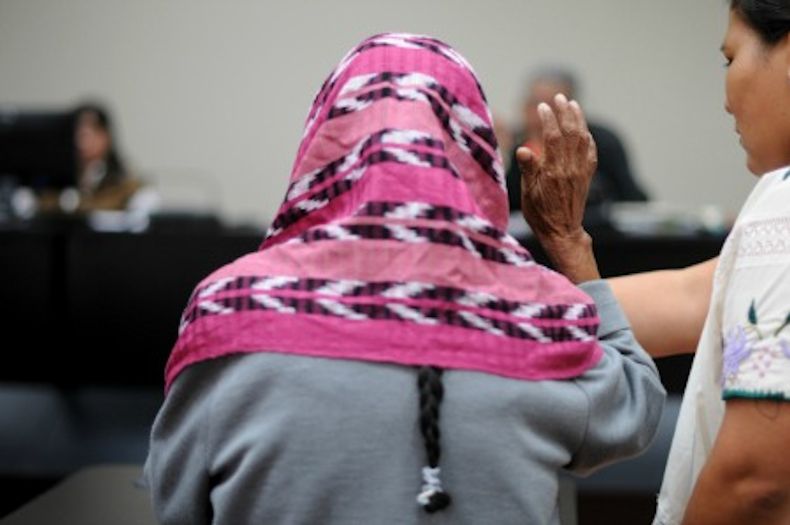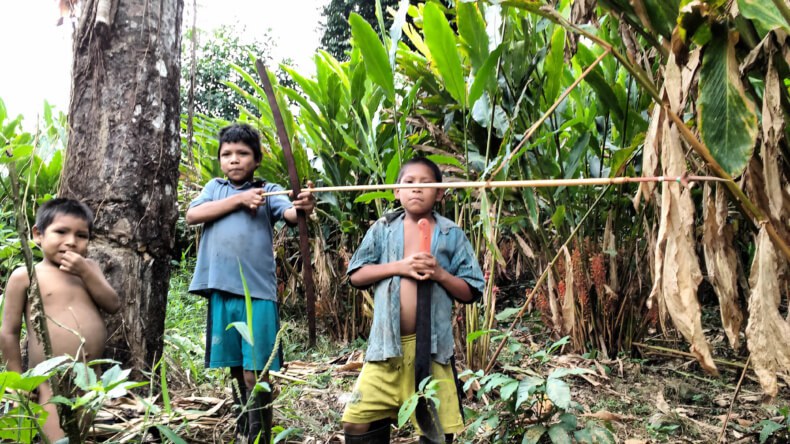
by Deep Green Resistance News Service | May 14, 2016 | Colonialism & Conquest, Indigenous Autonomy
By Jake Ling / Intercontinental Cry
This is the third installment of “The Guardians of Mother Earth,” an exclusive four-part series by Intercontinental Cry examining the Indigenous U’wa struggle for peace in Colombia.
Featured image: U’wa children are now taught their native language in the resguardo’s bilingual schools, as well as lessons in Natural Law: how to protect, care and safeguard Mother Earth. Photo: Jake Ling
In the cloud forests on the eastern cordillera of the Colombian Andes there is no internet, and phone reception is limited to a few lookouts on the craggy cliffs above the tree line. As news from the U’wa mobilization in the paramos surrounding the sacred Mount Zizuma filter down to the base of the mountain range in the Boyacá Frontier District on the Venezuelan border, Berito rests in his wooden shack recovering from tuberculosis. As he slowly convalesces, the indigenous leader has time to reflect on the struggle that has defined much of his life and can take pride in this next generation of pacifist U’wa warriors who have taken up the fight to save Mother Earth in his absence.
“When we start to educate, we need to educate two worlds,” Berito told IC. “One is of the west through its books, then there is the harmonious civilization of the spiritual, our own culture, which teaches peace with the environment and the house of nature.”
Education has been a key strategy to the U’wa leadership to ensure the tribe’s survival into the 21st century. Berito learned the importance of educating U’wa children about Natural Law, which predates and takes precedent over the laws of men, as the result of a childhood trauma: as a young boy, he was kidnapped by Catholic missionaries and forced to live in a convent until, after several years, his mother rescued him. The missionaries named him Roberto Cobaria, after the Cobaria river that ran past the mission. This arbitrary name followed him for most of his life as it was the name officially recognized by the Colombian government.

The 450 meter bridge that crosses the Cobaria River is what separates Berito’s house on the eastern border of the resguardo and the now reformed Catholic mission that once held him against his will. Photo: Jake Ling
The massive wooden convent that held the young Berito had enough rooms to house priests, nuns, cooks, cleaners, and at least 80 other abducted U’wa children. Today, however, this place that once perpetuated the cultural genocide of the U’wa has been transformed into a school that teaches their native language inside its classrooms with murals depicting their ancient mythology decorated along the walls. In the playground the unruly grass and patches of moss and lichens cover the cracked base of a neglected statue of the Virgin Mary, but the intergenerational scars left by the missionaries are evident in the survivors and their families.
“They took my mother when she was 6 or 7 years old and kept her there for about 16 years,” Luis Eduardo Caballero, the Fiscal (legal representative) of the U’wa Peoples, told IC. According to Caballero, the Catholic Church invaded from opposite ends of U’wa territory in the late 1940’s via the Andean plateaus of Boyacá as well as the lowlands beside the Cobaria and Arauca rivers. A rival evangelical organization called the Summer Institute of Linguistics, located a short drive outside of U’wa territory, was also involved in the systematic kidnapping of indigenous children.
“They prohibited our rituals, our fasts, our celebrations called the dance,” said Caballero, adding that the missionaries lured the children away under the guise of providing free education. Those inside the convent who spoke their native language were punished. “They weren’t able to make my mother stop speaking U’wa, but many others, yes.”

The Catholic mission that once perpetuated the cultural genocide of the U’wa has been transformed into a school that teaches the U’wa native language. Photo: Jake Ling

Murals depicting their ancient mythology are now decorated along the walls of the reformed Catholic mission. Photo: Jake Ling
As Berito grew to adulthood, he served as the governor of the U’wa and became a spiritual authority or Werjayá in the U’wa tongue, a shamanic healer in charge of communicating with the superior powers that inhabit nature: the rivers, the plants, the sun, and the stars. His childhood experience in the convent galvanized him to take the fight for his people’s rights outside the isolated cloud forests to the capital Bogotá and then beyond Colombia’s borders. It was only until December of last year, that Berito traveled to a judicial office in the capital to officially change his name from Roberto Cobaria, that which was placed on him by the Catholics, to Berito KuwarU’wa KuwarU’wa, the name used by his people.
The leaders significance as an influential elder statesmen for Colombia’s Indigenous Peoples has not gone unremarked. “Berito taught Colombia’s indigenous people and the world the importance of the globalization of resistance, how to defend the beloved Earth and how to fight against climate change.” said Luis Fernando Arias, the Chief Councilor of the National Indigenous Organization of Colombia (ONIC).
“Internationally, Berito is the most well-recognized face of the U’wa struggle.” said Andrew Miller, who accompanied the U’wa leader with Amazon Watch to meet Avatar director James Cameron in his Los Angeles living room. “Especially in the late 1990’s, Berito was a global ambassador of the U’wa’s beautifully poetic cosmology that captured many people’s imaginations. He struck up a bond with Terry Freitas, the young activist who helped galvanize the international movement in support of the U’wa, as well as people like Atossa Soltani, Amazon Watch’s founder.”
Terence Freitas was the co-creator and coordinator of the U’wa Defense Working Group that was essential in drumming up international support for the U’wa. The young activist transformed his bedroom at his mother’s house into the de-facto HQ for the U’wa’s international campaign against Occidental Petroleum in the late 1990’s. Even his mother was unaware of the extent of her son’s involvement until one morning she found Berito, the leader of 7,000 indigenous people from the isolated paramos and cloud forests of eastern Colombia, sleeping on the living room floor of her suburban Los Angeles home.
“I noticed that he immediately bonded with Roberto, there was a link between them,” said Francois Mazure from the EarthWays Foundation that hosted Berito during his visit to Los Angeles. “Roberto was the father and Terry was the son.”
In 1997, after meeting with the directors of Occidental Petroleum in Los Angeles, Berito was kidnapped on his return to Colombia by gunmen who tried to force him to sign a drilling agreement. He refused and they beat him. In 1998, Freitas accompanied Berito to Al Gore’s office to meet the environmentalist vice president after the U’wa leader was awarded the Goldman Environmental Prize. Unfortunately Al Gore, whose father sat on the board of Occidental Petroleum and owned a small fortune in the company’s shares, never pressured Oxy publicly.
A year later Berito invited Freitas and two native American activists, Lahe’enda’e Gay and Ingrid Washinawatok, to help set up schools to protect the U’wa language and culture and defend their way of life from the oil industry. Washinawatok was a world-renowned 41-year-old indigenous activist known as Flying Eagle Woman of the Menominee Nation of Wisconsin and a rising leader in the struggle for indigenous rights. She also directed the Fund for the Four Directions, which promoted the revitalization of indigenous languages and cultures. Lahe’ena’e Gay was a 39-year-old member of Hawaii’s Kanaka Maoli Nation, as well as the founder and director of the Pacific Cultural Conservancy International, which works to preserve cultural and biological diversity.
Freitas knew the risks. On a trip to U’wa territory a year earlier he reported being observed and followed on various occasions by individuals he believed were paramilitaries. During that same trip he was stopped by the Colombian military and forced to sign a declaration that absolved the army of any responsibility for his security. He interpreted the act as a threat. The shared vision of Berito, Freitas, Gay and Washinawatok to develop schools to teach the next generation of U’wa children a non-colonial curriculum; alongside lessons on Natural Law, which was set down by the divine spirit Sira entrusting the U’wa with the guardianship of Mother Earth, outweighed the risks.
As Berito guided the three activists on their way to the airport to leave Colombia, they were kidnapped by masked gunmen. While the U’wa leader was immediately released, the bodies of the activists were found a week later bound and blindfolded with multiple gunshot wounds in a Venezuelan cow field over the Arauca river.
Because the FARC was then in preliminary peace talks in the late 1990’s, presaging more recent events, the guerrilla group appeared to have little to gain and much to lose from the kidnapping and executions. Indeed, the FARC high command was quick to deny complicity, in order to protect those fragile peace talks.
The armed men at the road block where the group were kidnapped also did not fit the profile of the local FARC – they were allegedly much younger, not dressed in fatigues, and had their faces covered – leading some to wonder if they were a rogue group opposed to the peace accords. The stretch of highway through Arauca province where the group had been traveling was dominated by the paramilitaries, who at the time had been waging a campaign of extermination against trade union leaders, human rights activists and suspected guerrilla collaborators. Eventually, however, a rebel commander from the guerrillas acknowledged: “Commander Gildardo of the FARC’s 10th Front found that strangers had entered the U’wa Indian region and did not have authorization from the guerrillas. He improvised an investigation, captured and executed them without consulting his superiors.”
Washinawatok’s Menominee Nation and various other U.S. indigenous rights groups accused the U.S. State Department of destabilizing their own negotiations with the FARC for the release of the activists, which they had believed would be imminent. During the failed peace talks of the 1990’s, the US State Department had released $230 million in military aid to the Colombian army, and fighting in the north between the army and their right wing paramilitary allies against the FARC had left 70 people dead on both sides.
Meanwhile, Occidental Petroleum wasn’t just spending millions to lobby the U.S. government to increase military aid to Colombia – it was providing direct financial and logistical support to the Colombian military. The oil giant was also funding private security firms like Air-Scan, which carried out the cluster-bombing massacre of Santo Domingo on Occidental’s behalf, as well as the paramilitary death squads involved in kidnapping, torture, extrajudicial killings and massacres of civilians across the region.
Most surprisingly, however, was the U.S. multinationals’ links with Colombia’s marxist guerrillas, confirmed when Oxy Vice-President Lawrence Meriage gave testimony before the U.S. House of Representatives in 2000. He admitted that Occidental employees regularly made payments to members of the FARC and ELN. Meriage’s acknowledgement of Oxy’s work relationship with the guerillas came three years after the ELN and FARC were declared “Foreign Terrorist Organizations” in 1997, making it a crime to provide material support to these groups.
Meriage’s testimony was also consistent with the actions and admissions by long-time Occidental leader Armand Hammer, who reports in his biography how Occidental’s Latin American security chief, former FBI employee James Sutton, was fired when he spoke out against the company’s payments to the ELN. “We are giving jobs to the guerrillas…” Hammer told the Wall Street Journal in 1985 “…and they in turn protect us from other guerrillas.”
An investigation by the LA Times found that Occidental Petroleum was funneling millions of dollars to the ELN guerillas as well as jobs and food for their members. “The rebels used the money to gain new recruits and weaponry,” the LA times stated, claiming the ELN were on the verge of being wiped out by the Colombian military in the early 80’s before receiving Oxy’s financial backing. “In effect, Occidental rescued the group that later turned against it.”
After his passing, Freita’s former girlfriend lashed out at Oxy in a letter to Vice President Al Gore, referring to the company’s friendly links with the guerrillas. Berito later testified to Amnesty International and the Inter-American Commission on Human Rights to complain about the incident that took the life of three of the U’wa People’s greatest friends and allies. An article in the LA Weekly eulogizing the young activist after his death stated: “In May 1997, Freitas met the man who would change the course of his life: U’wa leader Roberto Cobaria.” Terry Freitas was 24 years old when he was executed.
The international campaign against Occidental Petroleum soon hit critical-mass. With many still reeling over the death of the three activists, protests against the oil giant were launched in London, Hamburg, Lima, Nairobi and several cities across the United States. The U’wa leader Berito Cobaria once again traveled from the cloud forests of eastern Colombia to the west coast of California where he planned to challenge Oxy CEO Ray Irani at the company’s annual shareholder meeting. Meanwhile as Occidental Petroleum funded all sides of Colombia’s brutal civil war, the flow of hundreds of millions of dollars of crude oil to the Caribbean coast continued.
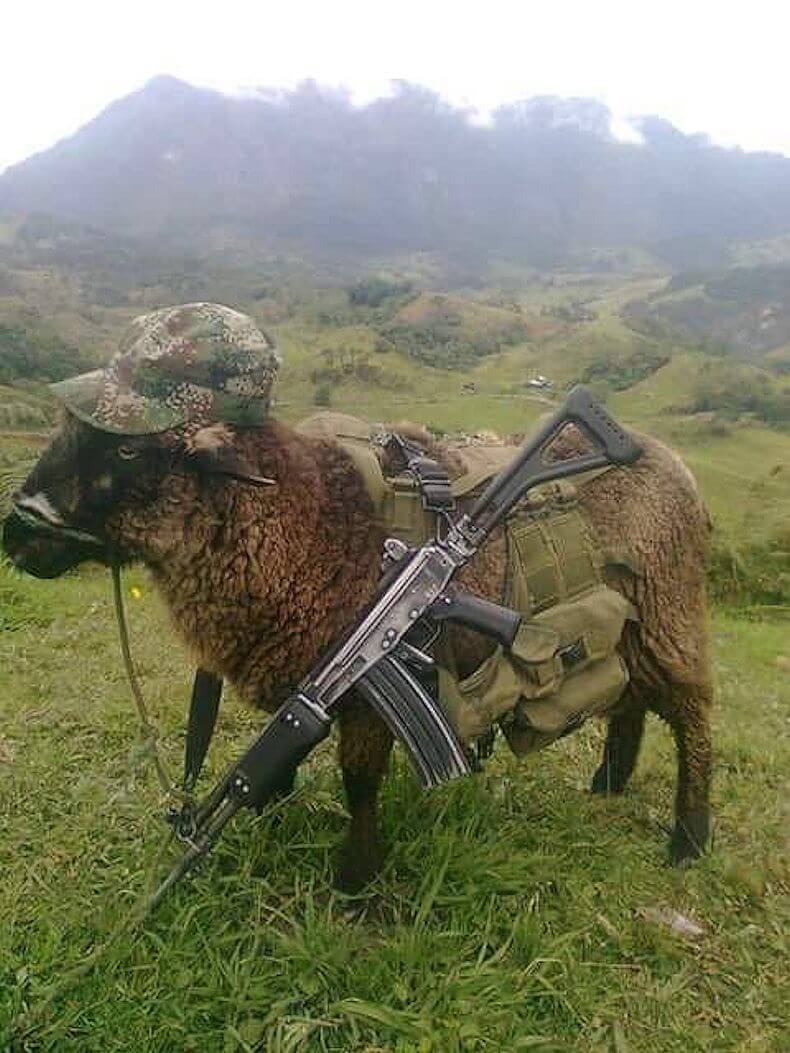
by Deep Green Resistance News Service | May 10, 2016 | Indigenous Autonomy, Obstruction & Occupation
U’wa struggle against tuberculosis, parasitic worms, climate change and the threats of violent paramilitary repression
Featured image: “The U’wa were sent a photo of a sheep in military gear and carrying a rifle, implying that they are associated with the guerrillas. These are very serious accusations, providing a political rationale for violent paramilitary repression against the U’wa.”
—Andrew Miller, Director of Advocacy at Amazon Watch. Photo: unknown
By Jake Ling / Intercontinental Cry
This is the second installment of “The Guardians of Mother Earth,” an exclusive four-part series examining the Indigenous U’wa struggle for peace in Colombia.
Nestled below the snow-capped mountains on the eastern cordillera of the Colombian Andes is the town of Güicán, known internationally to hikers as the gateway to Colombia’s magnificent Cocuy National Park. To the east of the mountain range the impenetrable tropical vegetation provides cover from air strikes for the guerrilla armies along the Venezuelan border. On the western border of U’wa territory the vegetation disappears with the altitude into a vast network of Andean peaks, valleys, and pristine wetland ecosystems called paramos.
It was here late last year during the October 25 municipal elections when the mountains surrounding Güicán became the scene of an ELN ambush resulting in the deaths of one policeman and 11 soldiers from Colombia’s High-Mountain Battalion. The battalion had left the U’wa resguardo at 3am and marched down a narrow mountain trail while carrying 130 votes cast by the remote indigenous communities of Bachira when they stopped to rest only to come under fire from rifles and guerilla rocket-launchers called “tatucos.” The sergeant leading the group communicated back to base that his security detail of 34 soldiers and two policemen charged with protecting delegates from the voting commission as well as an indigenous U’wa guide were under attack when radio contact was lost.
A coordinated air and ground assault was launched by the Colombian military to rescue the survivors and recover the bodies at an altitude of 9,842 ft where the tough mountain terrain makes helicopter access difficult. Two police were found wounded but alive while two soldiers as well as the U’wa guide and the civilians from the voting office remained unaccounted for as the ELN disappeared into the mountains. Vladimir Moreno, an indigenous U’wa leader, told El Tiempo there was no precedent for such violence in the region and that historically the guerillas had never interfered with the votes of local U’wa. “This is a peaceful community,” he said.
“We will request from national and international organizations to demand that the armed actors in the resguardo withdraw,” Moreno told Caracol Radio, “and we also demand from the Ministry of Defence that the Army clears out of the area within the resguardo because this has violated international humanitarian law.”
The incident, which was the most violent confrontation between the ELN and the state military since peace negotiations between the FARC and government started three years ago in Havana, resulted in the consequent militarization of U’wa and rural communities across the western border of the resguardo.
Now, six months later, Güicán is the epicenter for a non-violent U’wa mobilization: for the last few months the indigenous community has blocked the entrances of the Cocuy National Park. “The U’wa Nation is the Guardian of Mother Earth and from now into the future we will not permit tourism into the national park,” Yimy Aguablanca, an indigenous leader from Güicán, told IC on March 21, 2016. He added that tourism is affecting the water and the entire eco-system around the park and that non-indigenous rural people have joined the protest.

An U’wa Indigenous Guard. Photo: Tatiana Vila Torres / Kinorama Copyleft
The scarce facilities like rubbish bins and toilets in the state-run park mean some of the trails are littered with trash and visitors are forced to defecate beside the mountain streams that supply drinking water for surrounding communities. Outrage over the poor administration of the park was further inflamed in February when a charity match of high-altitude soccer was broadcast over YouTube. The match took place on the glacier of the U’wa’s sacred mountain Zizuma, the resting place of their divine beings. Known as Mount Cocuy in Spanish, an estimated 90 percent of Zizuma’s glaciers have disappeared in the last 150 years due to climate change. What little ice there is left is receding at a rate of 25 meters per year.
“Today we cry as our Zizuma is condemned to disappear,” went out the U’wa Communiqué that was broadcast through social media. Yimy Aguablanca said this latest mobilization of the U’wa will not stop until the state hands over administration of the park to the U’wa. So far, their calls for a direct dialog with the Minister of Environment have been ignored. The Constitution of 1999 allotted 220,275 hectares for the U’wa but this is a fraction of their ancestral lands, which once included the Cocuy National Park and areas rich with oil and gas reserves, which were conveniently left out of the agreement by the Colombian government.
In 2015, the U’wa High-Council made up of indigenous leaders from different communities across their territory, approved the creation of the Indigenous Guard. These guardians are responsible for territorial control and defense, and while unarmed, they have a mandate to ensure that no one enters the reserve without authorization, especially technical staff like geologists. The decision to form the Indigenous Guard came in response to an event in May 2014, when the U’wa detained functionaries from the company ENCOMINING who were in the Campo Hermoso region of their territory attempting to take coal samples. The importance of the current mobilization around the Cocuy National Park to not just the U’wa but also non-indigenous rural communities in the region is evident by the fact that rural farmers are now standing side by side with the Indigenous Guard to block all entrances to the park.
“Today when we look at our rights over our territory it is not the same as that of our ancestors,” Berito told IC. “It has been exploited, violated, distributed, but still even now we must always protect the water, the animals, and the forests.”
It was during ‘la Violencia’ — a dark period in Colombian history that began in 1948 — when the borders of the U’wa Nation’s territory were first reduced as thousands of refugees fleeing conflict from other parts of the country settled on the fertile banks of the Arauca. Instead of seeing enemies that needed to be vanquished, the U’wa saw victims worthy of compassion and retreated further into the mountains. Over the next 10 years, 200,000 people were killed as the civil war engulfed the country. La Violencia was eventually resolved by a power-sharing agreement in 1958 that turned Colombia into a dictatorship and consequently set the stage for a Marxist guerrilla insurgency against the central government.
Since 1964, another 260,000 people have been killed in the current incarnation of the Colombian armed conflict, and the war-torn provinces of Arauca, Casanare, Norte de Santander and Boyacá that overlap U’wa territory have become some of the most violent and militarized states in the country. In the north of U’wa territory in Norte de Santander, when word spreads of the Colombian army’s proximity, U’wa men race back from the fields to their families so the women are not alone in their homes.
To the south of the Cocuy National Park in Boyacá province, land that once belonged to the U’wa and is still considered sacred by their people has been violated by turning it into a permanent military base to defend nearby petroleum wells from five divisions of the FARC’s formidable Eastern Block and the heavy concentration of ELN fighters in Arauca and Casanare.
Although U’wa territory falling within the borders of the national park is protected from mining under the constitution, the proximity of these intense large-scale petroleum and gas exploitation projects has greatly affected the region’s fragile and delicately interconnected ecosystems. The Andean paramos that make up much of the terrain in the south and west of U’wa territory as well as the national park absorb water like giant sponges before releasing it into the rivers that nourish all life in the cloud forests on the eastern edge of the cordillera and the vast wetland Savana called Los Llanos that stretches thousands of miles into Venezuela.

An U’wa bi-lingual teacher named Jose Cobaria sharpens his machete in the unusually dry Cobaria river. “The government invests all of its money in guns and war not education and health.” Photo: Jake Ling
These rivers are symbols of spiritual purity in U’wa cosmology, but a severe drought engulfing the region caused by overzealous mining in the Andean paramos, climate change and El Niño has turned these once mighty tributaries flowing through the U’wa ancestral lands into stony creek beds. To make matters worse, the once crystalline waters they carried from the snow-capped peaks and glaciers of the Sierra Cocuy and Güicán have been infected with a parasitic worm that stunts the indigenous children’s growth and swells their bellies, leaving them malnourished and lethargic while depleting their immune systems.
A dose of antibiotics from Cubará hospital can control the worm, but many indigenous families cannot afford the journey down the mountain to the town for a doctor’s prescription. Those that can make the trip to purge their children’s stomachs find out that after drinking one glass of water the worm is back. “We have to defend our health,” Berito told IC, “and this means examining the exploitation and contamination of the water which has cast a shadow over the rivers.”

“U’wa locals say the drinking water didn’t used to make them sick and that the parasitic worm which has recently contaminated the water supply severely affects indigenous children, swelling their stomachs and leaving them malnourished.”
Further up the mountain, 50-year-old Kuiuru Kobeua has worked 8 hours a day for the last 14 days planting seeds on a small plot carved out of the forest to make sure his wife and three children do not go hungry come harvest. Two months ago, when his test for tuberculosis in Cubará hospital turned out negative, he was sent home with a packet of Ibuprofen. Two months later, he has trouble talking between violent coughs and the constant need to clear his phlegm-filled throat and lungs. He can barely afford another trip to Cubará and fears being turned back home again with nothing but another packet of painkillers. Meanwhile, the cough is not going away and he feels increasingly weak.

Until the Colombian government establishes a Tuberculosis Clinic in Cubará, the town’s under-resourced health clinic is unable to properly identify or treat the disease such as in the case of Kuiuru Kobeua, who was sent home from the hospital with nothing but painkillers. Photo: Jake Ling
“To prevent such cases of tuberculosis,” Yimy Aguablanca said, “we need to recognize and tell the world that the actual health policies of this government do not guarantee that our U’wa brothers are protected from the disease.”
On the other side of the U’wa’s ancestral territory the Earth First Journal reports that there are not enough seats for the patients in the tin-roofed off-the-grid medical clinic in Chuscal and that some of the sick are sprawled on the cracked floor tiles. Diseases such as tuberculosis, dysentery and leishmaniasis, a parasite spread by sandflies that attacks people’s internal organs, are rife. “We’re short of everything,” Eusebio Carceres, the head nurse at the isolated healthcare outpost, told Earth First. “Antibiotics, vaccines, lab equipment – we’re even short of clean drinking water because the oil spills have poisoned so many sources around here.”
Although the Colombian government routinely sends mining engineers into and around U’wa territory through state-run petroleum companies, the government’s failure to provide the region with uncontaminated drinking water or medical specialists to heal the community’s sick is striking.
The problems facing the U’wa are compounded by the limited arable land allotted to them in the constitution. It has forced them to change their agricultural practices. In decades past, the U’wa rotated crops to conserve soil quality and left areas to regenerate for up to 12 years before returning to ensure a bountiful harvest. Now the quality of soil is declining along with the quantity of their yields; sufficient food to feed the entire community is becoming increasingly scarce. Given the choice of clearing more of their sacred forests for agriculture or starving, however, the U’wa choose to fast. Amazon Watch neatly summed up the situation: although the U’was are pacifists who are unwilling to kill anyone for their beliefs, they are willing to die for them.
On the western paramos surrounding the sacred Zizuma, Yimy Aguablanca and a hundred other rural and U’wa protesters are standing firm despite the threats sent to the Indigenous Guard. On March 25, they received a cryptic photo of a sheep, grazing below the sacred mountain, dressed in guerilla military fatigues and carrying an assault rifle. The not-so-subtle threat means the U’wa have been categorized as an armed rebel group — and therefore a military target.
“When your protests disrupt an economic activity, you become a target of armed actors who operate on behalf of those interests,” said Andrew Miller, Director of Advocacy at Amazon Watch. He added that local politicians with ties to the tourism industry have been affected economically by the U’wa’s biocultural conservation efforts. Along with the threatening photo, Miller said that rumors are now circulating about the U’wa receiving bribes from the FARC to help them re-establish contraband shipment routes through the national park.
“These are very serious accusations providing a political rationale for a violent paramilitary repression against the U’wa,” Miller told IC. “The notion that the U’wa are associated with an armed group is absurd. They are actually radical pacifists by culture.”
The third installment in this series turns to recent history centered on Berito Cobaria, catholic missionaries and the international movement against Occidental Petroleum. It will be available soon on Intercontinental Cry.
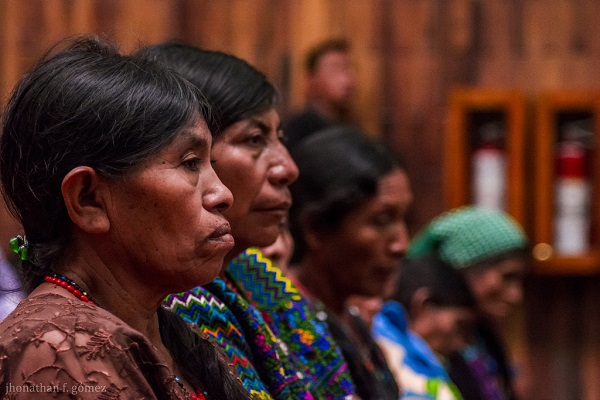
by Deep Green Resistance News Service | Feb 21, 2016 | Lobbying, Rape Culture
By Jhonathan F. Gómez / Upside Down World
All photos from Supreme Court trial by Jhonathan F. Gómez
Maya Q’eqchi’ women survivors recently entered the Supreme Court in Guatemala as part of the Sepur Zarco case to demand justice for sexual violence, sexual and domestic slavery, forced disappearances and murder, crimes committed during the internal armed conflict of 1960-1996. On February 1, 2016, Army Lieutenant Colonel Francisco Esteelmer Reyes Girón and military commissioner Heriberto Valdés Asij appeared before the court as another historic trial began.
The Sepur Zarco case is representative of the current state of justice for women in Guatemala. It serves as a reminder that the work towards bringing those responsible for genocide and crimes against humanity is an extensive and challenging process anywhere in the world.
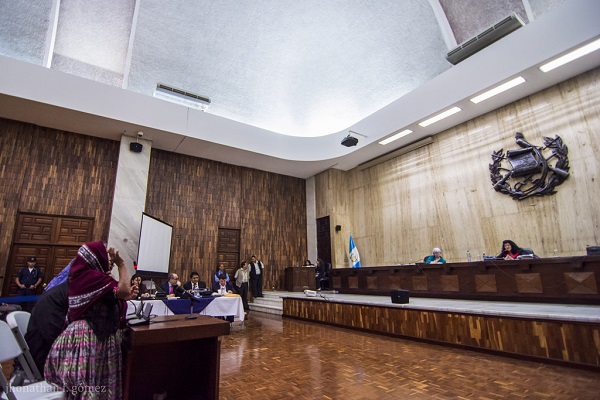
The case goes back to 1982, when the army built a military outpost between the departments of Alta Verapaz and Izabal. Built by forced labor from men of the communities of Panzós and El Estor, it was designated as a resting area for the troops. Late in 1982, the army captured and disappeared Maya Q’eqchi’ men who were fighting for their rights to the land in the area. Consequently, the army took advantage of the widowed women and declared them “alone and available,” forcing them into domestic and sexual slavery. The women were subjected to inhumane conditions, repeatedly raped, gang raped and forced to cook and clean for the army.
These crimes occurred when retired general José Efraín Ríos Mont Ríos Montt was president. Part of his government’s policy was to eliminate the Mayan people by way of displacement, disappearances, murder or forced exile. (Ríos Montt is currently waiting retrial to face justice for his crimes.)

In 1993, the United Nation’s Historical Clarification Commission collected testimonies which allowed for an understanding of what happened. However, a broader understanding of what took place began to surface further in 2000 when the Community Research and Psychosocial Action Team (Equipo de Estudios Comunitarios y Acción Psicosocial, ECAP) conducted psychosocial work with women of the Sepur Zarco region.
The roots of this landmark case are part of a living history which Maya Q’eqchi’ women have been working for years at the community level in the pursuit of justice. In 2009, an independent psychosocial investigation, which led to the publication of a book called Tejidos Que Lleva el Alma (The Weavings that Our Soul Carry) was conducted by ECAP and the National Union of Guatemalan Women (Unión Nacional de Mujeres Guatemaltecas, UNAMG). The book’s aim was to bring the stories of Mayan women survivors into the public consciousness.
In 2010, a symbolic Court of Conscience (Tribunal de Conciencia) against sexual violence for crimes committed during the armed conflict was conducted as a public act by the women survivors. It signaled a breaking of the silence and promoted the sharing of stories with the clear objective that nothing of that nature should ever happen again. The event was organized by various community organizations and with the support of multiple embassies including those from Costa Rica, Spain, Germany Norway and Sweden. Following the symbolic act, the women took a step forward with strategic litigation within the Guatemala justice system.
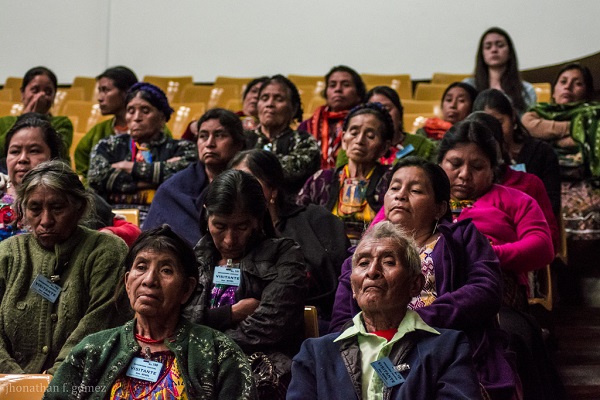
The Breaking the Silence and Impunity Alliance (Alianza Rompiendo el Silencio y la Impunidad), which consists of three grassroots organizations, came together the same year to accompany the legal proceedings of the women survivors. The women survivors have waited over 30 years to see any inclination of justice, and this case can therefore have a large impact in Guatemala and around the world.
The significance of the case cannot be overstated. It is the first time in the world where a national court, in the context of a criminal trial will hear charges against sexual violence during war, as well as the first time a national court will hear charges against sexual and domestic slavery, also in the context of war. The case can set precedents on how sexual violence is judged at a national and international level. Ada I. Valenzuela López from UNAMG states, “In our society, no one else will position sexual violence as an issue in this context. It is a violence which has been silenced for many years. It is almost never at the forefront of any debate in the courts or our society.”
The case stands to move public opinion forward in the struggle for gender justice. It can serve as a step to strengthen trust in a justice system that is capable of hearing the voices of women, and not shaming nor stigmatizing them for speaking out as survivors of sexual violence. It is particularly important for an indigenous population that has been historically discriminated and marginalized to trust in due process. Fifteen women have already testified during the intermediate phase of the case. Many of them have faced threats because of their testimony, yet all of them continue to stand strong because they share a collective understanding of the importance of the trial.
On September 2011, criminal charges were filed in Puerto Barrios, Izabal against military officials Reyes Girón and Valdés Asij. On December, 2011, exhumations were performed at the military outpost. In July of 2012, the prosecutor’s office requested before the Supreme Court that the case be transferred to the High Risk Court. In September of that year, survivors and witnesses presented testimonies before Judge Miguel Ángel Gálvez Aguilar who precedes High Risk Court B.
Arrests were made for Reyes Girón and Valdés Asij in June 14, 2014. On June 23, the first hearing was held and in October, the intermediate phase began which prompted the judge to request a trial date. Immediately after the defense filed a writ of amparo, a legal remedy for the protection of constitutional rights, which was rejected by the Constitutional Court in April of 2015.
In March, April and May of 2015, hearings were suspended because the defense attorneys were not present and because of health problems by Francisco Esteelmer Reyes Girón. Esteelmer Girón had been hospitalized and the defense stated that he was in “poor health.” On June 23, the judge restarted the public debate and the case was sent to the High Risk Court A, comprised by judges Yassmín Barrios, Patricia Bustamante and Gerbi Sical.
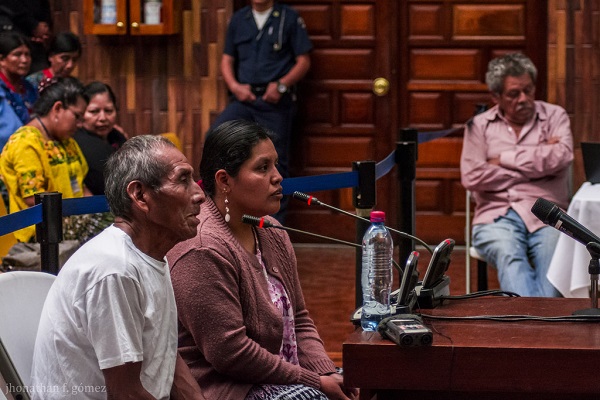
On February 1 of this year, the trial began. It faces many challenges, both in the domain of public opinion, as well as in the trial itself. The defense continues to defame survivors’ organizations, witnesses and uses legal methods to delay the trial. Many organizations have denounced the defense’s methods as a way to evade justice and promote a culture of impunity. Jo-Marie Burt from the Washington Office on Latin America reiterates that “the challenge here is to prove that these types of crimes can be investigated, brought to trial and judged. And to seek to generate mechanism or protocols for the army understand that violence against women cannot be used as an instrument of war, and that women are not war trophies.”
On February 9, the plaintiffs presented over 30 boxes as evidence which contained the remains found in various exhumations which the Forensic Anthropology Foundation of Guatemala (Fundacion de Antropologia Forense de Guatemala, FAFG) conducted. As the contents of the boxes were presented, many people who attended the trial as observers and supporters walked out of the courtroom because of their graphic nature. Evidence of this nature has not always been used at such trials, making it an even more important method of illustrating the magnitude of the crimes.
As a show of support for the Maya Q’eqchi’ women who will be testifying, women from various regions across the country have been present through the trial. As the country watches another historic trial unfold, the survivors are clear on their position. They seek justice and will not rest in peace until justice is served. They want to bring the issue of sexual violence into the public conversation and to show that it is hard for women to speak out against this type of violence. They want their voices to be heard, their truth to be known. They want society to understand that what happened to them was not their fault, and most importantly, that no other woman in Guatemala, or anywhere in the world, experiences what they lived through.
Jhonathan F. Gómez, is a documentary photographer currently living in Guatemala City. He is commitment to documenting the subaltern and diasporic realities of Guatemala as they relate to historic memory, race, class, gender, sexuality, identity and justice.















